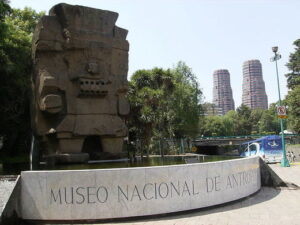
Monolith of Tlaloc
As many nations around the world prepare for Christmas, this week’s blog post examines an art heist that took place at the Museum of Anthropology in Mexico City on Christmas in 1985. On that day, unknown assailants snuck into the museum before dawn and removed 140 objects hailing from the Mayan, Aztec, and various other native Mexican communities. Because of the objects’ small size (nearly all of them were around 1 inch in size) they were easily removed and transported. The stolen artifacts included a jade mosaic funerary mask and an obsidian monkey-shaped vase worth over $20 million. The thieves knew what they were after, since they took the best objects from each display.
Museum curator Felipe Solís bemoaned the theft as a national tragedy: “[The thieves] robbed a piece of our history. How can we put a price on it?” Similar to the infamous Isabella Stewart Gardner Museum theft in Boston on St. Patrick’s Day in 1990 (when the city of Boston was in the midst of holiday celebrations), the Mexico City heist seems to have been a combination of planning and circumstance. Not only did it take place early on Christmas Day, a holiday widely celebrated across the country that would make the museum vulnerable that day, the museum’s alarm was faulty and the 9 security guards working that day apparently got drunk during the night, as evidenced by cookies and glasses with liquor residue found at the museum.
Fortunately, unlike the Isabella Stewart Gardner case, the thieves were found and all the items were recovered three years later. At the time, the director of collections of the Los Angeles County Museum of Natural History noted that it was like “trying to fence the Mona Lisa.” A former dealer opined that “no reputable dealer” would go near the loot. Many industry professionals were also concerned that the thieves would destroy the artifacts if they went unsold (something often done in order to destroy evidence connecting thieves to their misdeeds). Although the targeted nature of the theft initially led Mexican officials to conclude that seasoned professionals – potentially KGB agents – were responsible and that the objects had been exported immediately to the U.S. for sale, the truth was far different. In fact, it was a pair of amateurs (university dropouts, to be exact) who carried out the robbery. The thieves visited the museum over 50 times before jumping over the fence, crawling through an air-conditioning duct, and looting seven display cases.

Replica of Montezuma’s Headdress (in Museo Nacional de Antropología e Historia, Mexico City)
As one of the largest Pre-Columbian artifact thefts in history, the heist had a profound impact on the collective imagination, spurring a 2017 film titled Museo (Museum) which stars Mexican actor Gael García Bernal. The film recognizes that the Christmas Day theft was not the first instance of plunder from Mexico because the indigenous people of the nation had long faced the tragic theft of their heritage. Quite poignantly, Museo opens with footage of the removal of the Monolith of Tlaloc (the Aztec god of rain). It was discovered in the late 19th century in Coatlinchan, but in 1964 the 168-ton statue was moved to Mexico City to be displayed outside the National Museum of Anthropology. In doing so, the revered statue was removed from its original home, and some locals even protested the move. The film makes several references to the theft of indigenous items of cultural significance, including the statement that Montezuma’s headdress in the Mexico City museum is a copy because the original was “already stolen.” The famed headdress, made of nearly 500 quetzal feathers with sewn-on gold detailing, was removed from Mexico, mostly likely during the 16th century. It likely traveled to Spain, and then ended up in an Austrian collection in Innsbruck in the 1590s. It eventually became part of the Museum of Ethnology in Vienna, Austria. In 1991, the Mexican government formally requested the return of the treasure, but the Austrian museum declined, stating that it was not possible to safely return the cultural jewel. The ownership over this piece is still a source of contention between Austria and Mexico.
Pre-Colombian artifacts have become increasingly popular among collectors, fetching millions of dollars at auction – though not without controversy. In September 2019, a French auction house proceeded with the sale of dozens of such artifacts despite concerns from the Mexican and Guatemalan governments that the items were looted. The lots sold for $1.3 million, twice the initial estimate. These artifacts have also been subject to wider debates on colonialism and illicit trafficking. Now more than ever, it is crucial for collectors, purchasers, and sellers of art and antiques, including archaeological pieces, to do their due diligence and establish the provenance of items. At Amineddoleh & Associates, we assist clients with this process every step of the way, ensuring that transactions comply with applicable regulations so that they can enjoy their collections with peace of mind.
The Amineddoleh & Associates team wishes you all a Merry Christmas and Happy Holidays…without art thefts!